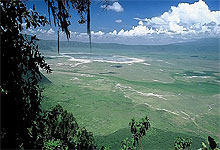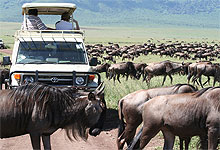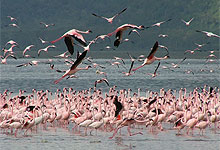Ngorongoro
Crater
Ngorongoro
Conservation Area, Tanzania
(Ngorongoro
Crater is accessed by road from
Arusha to Lodoare Entrance Gate is 160 Kilometers long.
As of recently, the entire journey is on tarmac and
it takes about two hours. Unless you stay on the main
roads, which are graveled, a 4x4 vehicle is essential
when entering the Ngorongoro Conservation Area and the
Serengeti National Park).

Ngorongoro
Crater in Tanzania
|

Ngorongoro
Crater Game Drive
|
 Ngorongoro Crater
Lake
Ngorongoro Crater
Lake
|
Ngorongoro
Crater & Ngorongoro Conservation Area - Tanzania
Ngorongoro
Crater View
Rates, Discounted Prices - Book a Safari & Save
Now!
The
Ngorongoro Crater is a natural amphitheater
created about 2 million years ago when the cone of a
volcano collapsed into itself, leaving a 100 square
mile (259km²) caldron-like cavity. This caldera,
protected by a circular unbroken 2,000-foot high rim
(610-metres), contains everything necessary for Africa's
wildlife to exist and thrive.
Ngorongoro
is on Tanzania's 'northern safari circuit', and receives
a good number of visitors who stay in lodges around
the crater. Game viewing vehicles descend the steep
crater wall every morning and spend the day on grass
plains that are teeming with animals.
However,
the dark of night belongs to the animals, and all vehicles
must leave the crater floor by sunset. Early man also
flourished around here at Olduvai Gorge, not far from
the Ngorongoro Crater. This is known because in 1960,
Mary Leakey discovered a 1.75 million-year-old Homo
habilis (nicknamed 'The Handyman' for his tool making
skills), who represents mans first step on the ladder
of human evolution.
The
Masai are the current human inhabitants and are at liberty
to live within the sprawling 2,500 square mile (6,480km²)
conservation area around the crater.
The
Masai never cultivate land as they consider it demeaning.
Instead they graze cattle, which hold a god-like status
in Masai culture, and in return the cows provide almost
everything necessary to live; meat, skin, milk, dung
for the walls and floor of their huts, and warm blood
extracted from the neck of a live cow and mixed with
milk as an iron rich food.
Animals
& Birds found in the Ngorongoro Crater
The
'lost world' of Ngorongoro was home to pigs the size
of a hippopotamus, sheep-like beasts with 6-foot (3
metre) horns and three-toed horses. Nowadays is inhabited
by about 30,000 animals, of which half are zebra and
wildebeest.
This
is the perfect situation for predators and spotted hyenas
and lion's lord over this domain. There are also some
leopards, cheetahs and three species of jackals. Tanzania's
few remaining black rhino are regularly sighted in the
crater, as are large herds of buffalo.
In
the lake on the crater floor and in the Ngoitokitok
swamps, reside plenty of hippos who remain partially
submerged during the day and graze on grass at night.
Although the area sustains a huge variety of species,
not all live down in the crater.
Some
are better adapted to roaming the extensive conservation
area surrounding the caldera. Elephant herds are noticeably
absent from the crater floor because the cows and calves
tend to prefer the forested highlands. They sometimes
appear at the crater rim but only rarely venture down
into the grasslands. Only mature bull elephants roam
the crater floor carrying around some massive tusks.
Also
absent from the crater are impala, topi and oryx who
reside more on the eastern Serengeti plains, but Grant's
and Thompson's gazelles appear in the crater in good
numbers. Giraffes are also missing from the crater as
they favor the umbrella acacia and wait-a-bit thorn
trees found higher up.
The
salt-whitened shores of Lake Magadi are turned a pastel
pink from thousands of flamingoes sifting algae and
shrimps from this soda lake. The lake also attracts
a myriad other water birds including avocets, plovers
and black-winged stilts whose long beaks probe the soft
mud.

Ngorongoro Plains Wildlife
|

Lion
of Ngorongoro Crater
|
 Spotted
Hyena Ngorongoro Spotted
Hyena Ngorongoro
|
Ngorongoro
Crater Seasons
As
the rim of the crater is 333 feet (2,235m) above sea
level it is cooler at the top than down on the crater
floor, where it can get extremely hot.
Rainy Season: Short rains are November
and December when it gets hot and humid, and the long
rains are from March to May.
Dry Season: typically it is dry from
June to October and it can get quite cold during these
months on the rim of the crater.
Ngorongoro
Crater Highlights
•
Plains teeming with grazing animals
• Dark manned lions
• Clans of spotted hyena
• Black rhino
Ngorongoro
Crater Accommodation |
|
Ngorongoro
Crater Safaris, Tours & Trips |
|
Booking
& Reservations for Ngorongoro Crater & Ngorongoro
Conservation Area. Ngorongoro lies just 60 kms Northwest
of Lake Manyara, 190 Kilometers West of Arusha and 145
Kilometers South East of the Serengeti - Tanzania
Booking
Office Tel: + 254 (0)
20 2437871
Mobile
: 0721242711 (Safaricom) - Kenya
Email:
[email protected]
